|
|
|
|
 

|

why to come to Salento
Condè Nast Traveller - The Guardian - The Times - The Independent - The Guardian/2
why do celebrities buy homes in Salento
Francis Ford Coppola (Film director)
 The Academy award-winning American film director Francis Ford Coppola spent years looking for a masseria in Puglia, before settling for one in Ugento at the tip of the Salentine peninsula. His family were originally from the area before moving to Basilicata in the 1700s, so he got back to his roots. The Academy award-winning American film director Francis Ford Coppola spent years looking for a masseria in Puglia, before settling for one in Ugento at the tip of the Salentine peninsula. His family were originally from the area before moving to Basilicata in the 1700s, so he got back to his roots.
|
Alistair McAlpine (Tory party treasurer and deputy chairman)
 The former Tory party treasurer and deputy chairman Alistair McAlpine and wife Athena own "Il Convento di Santa Maria di Constantinopoli" in Marittima di Diso, near Otranto. The property is run as a very upmarket B&B. It has eight guest rooms, each individually decorated, a cloistered courtyard and the rooms have the vaulted ceilings so typical of the area. The property is packed with McAlpine’s multi-ethnic art and book collections and the garden shows off his new passion: cacti. The former Tory party treasurer and deputy chairman Alistair McAlpine and wife Athena own "Il Convento di Santa Maria di Constantinopoli" in Marittima di Diso, near Otranto. The property is run as a very upmarket B&B. It has eight guest rooms, each individually decorated, a cloistered courtyard and the rooms have the vaulted ceilings so typical of the area. The property is packed with McAlpine’s multi-ethnic art and book collections and the garden shows off his new passion: cacti.
|
Helen Mirren (Oscar winning actress for "The Queen")
 A visit to Puglia while promoting her film "The Queen", plus knowledge of the region through old friend Lord McAlpine, led to the Oscar-winning star Helen Mirren buying a 500-year-old property near Tiggiano, not far from Lecce. It's a masseria, a farmhouse, and you may have seen tabloid photos of her frolicking in a red bikini on Salento rocks in summer. A visit to Puglia while promoting her film "The Queen", plus knowledge of the region through old friend Lord McAlpine, led to the Oscar-winning star Helen Mirren buying a 500-year-old property near Tiggiano, not far from Lecce. It's a masseria, a farmhouse, and you may have seen tabloid photos of her frolicking in a red bikini on Salento rocks in summer.
|
Amanda Lamb (TV presenter)
 The popular presenter of Channel Four’s 'A Place in the Sun'. Amanda Lamb owns a two-bedroom apartment in an 18th century palazzo in Nardò, about 30km from Lecce. The well-travelled presenter fell in love with an apartment when showing it some prospective buyers during filming of the show last year. They bought it, but Lamb got one in the building next door. The popular presenter of Channel Four’s 'A Place in the Sun'. Amanda Lamb owns a two-bedroom apartment in an 18th century palazzo in Nardò, about 30km from Lecce. The well-travelled presenter fell in love with an apartment when showing it some prospective buyers during filming of the show last year. They bought it, but Lamb got one in the building next door.
|
Suggs (Singer)
 Suggs, the ex-Madness singer and promoter of a certain frozen food line is a frequent visitor to the area and sometimes seen on Ryanair flights in to Brindisi as mentioned in our blog, written by new masseria owner Claire Simpson. Suggs owns a house at Borgagne, near Melendugno. Suggs, the ex-Madness singer and promoter of a certain frozen food line is a frequent visitor to the area and sometimes seen on Ryanair flights in to Brindisi as mentioned in our blog, written by new masseria owner Claire Simpson. Suggs owns a house at Borgagne, near Melendugno.
|

|
Instead of describing all the wonderful reasons why you should take a chance and visit Salento, we'll let you read what famous foreign journalists write about the land.
Ondine Cohane writes on "Condè Nast Traveller"
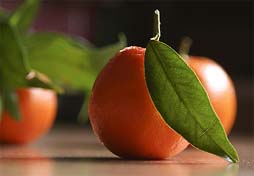 People have described Puglia as the new Tuscany, but the more time I spend here the more this description smacks of rather disingenuous marketing. Yes, there are hill towns and olive trees, but in every way it has a rougher, wilder, and more arid beauty, less contained and, for some, less digestible. Part of the charm of Tuscany is how its insular way of life has been relatively undisturbed since the Renaissance. Here in Puglia, I feel like I've stumbled into a place much more multifaceted in its makeup, where the interplay of different cultures over the centuries produced a markedly separate identity. People have described Puglia as the new Tuscany, but the more time I spend here the more this description smacks of rather disingenuous marketing. Yes, there are hill towns and olive trees, but in every way it has a rougher, wilder, and more arid beauty, less contained and, for some, less digestible. Part of the charm of Tuscany is how its insular way of life has been relatively undisturbed since the Renaissance. Here in Puglia, I feel like I've stumbled into a place much more multifaceted in its makeup, where the interplay of different cultures over the centuries produced a markedly separate identity.
I get a sense of just how complicated Puglia's history is when I arrive in Lecce, the entry point to the southern Salentine Peninsula. In the fifteenth century, Lecce (which grew into a city under the Romans) became a Bourbon stronghold and the base for a number of Spanish and feudal revolts, all brutally repressed; this was also the period when the city's most striking architecture was completed.
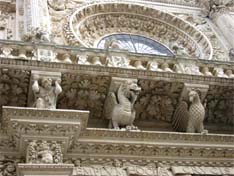 In the nineteenth century, Lecce was dubbed the Florence of the South, a title that seems apt given its particular beauty. While I don't consider myself a Baroque fan, Lecce's dilapidation somehow makes the over-the-top style less formal and tones down the flourishes, to great effect. The lack of crowds keeps the place peaceful, but it still feels lived in, and as with many of these Pugliese towns, there are always unexpected and often unexplained deviations from the norm: a duomo not centered, for example, with an unusually high campanile and only one entrance into the piazza. In the evening, I make my way to Casareccia, a restaurant and Lecce institution in a storefront on a nondescript street outside the city center, which exemplifies why Puglia is so refreshing. It's Friday night, and the place is packed with locals. There is no menu, no wine list, just a few courses prepared by the husband-and-wife team who run the show. The antipasti of roasted beets, baby potato salad, and roasted peppers encrusted with cheese, and the lightly battered capers, tomatoes, and olives are all commendably simple and utterly unforgettable. In the nineteenth century, Lecce was dubbed the Florence of the South, a title that seems apt given its particular beauty. While I don't consider myself a Baroque fan, Lecce's dilapidation somehow makes the over-the-top style less formal and tones down the flourishes, to great effect. The lack of crowds keeps the place peaceful, but it still feels lived in, and as with many of these Pugliese towns, there are always unexpected and often unexplained deviations from the norm: a duomo not centered, for example, with an unusually high campanile and only one entrance into the piazza. In the evening, I make my way to Casareccia, a restaurant and Lecce institution in a storefront on a nondescript street outside the city center, which exemplifies why Puglia is so refreshing. It's Friday night, and the place is packed with locals. There is no menu, no wine list, just a few courses prepared by the husband-and-wife team who run the show. The antipasti of roasted beets, baby potato salad, and roasted peppers encrusted with cheese, and the lightly battered capers, tomatoes, and olives are all commendably simple and utterly unforgettable.
"Let me bring you another starter, and after we'll talk of after and after," says Anna Maria Perrone, in Italian, who is wife, main chef, and waiter all in one. Shortly, she returns with a bowl of fava puree with strands of chicory in the middle. "It's the oldest dish in Puglia." I look at it with interest but don't have the foggiest idea how to eat it. She giggles and takes my fork to wind the strings of chicory like spaghetti, using the puree as the sauce. She pops a forkful into my mouth before wandering back to her small kitchen.
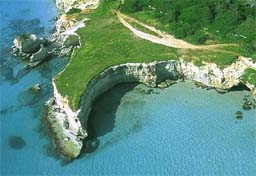 I continue the drive south from Lecce, heading to the southernmost cape of the peninsula, where the Adriatic and Ionian seas meet. The beaches are even more striking than farther north, stretches of crisp white sand and turquoise water with sailboats drifting lazily in the coves. Norman castles mingle with Byzantine churches perched over the water, Art Deco villas nestle into the rock, surrounded by cool pines and deserted, crumbling farmhouses. Among the small ports, Otranto has become a popular resort, with every rock and stretch of pier taken over by sunning Italian bodies. I continue the drive south from Lecce, heading to the southernmost cape of the peninsula, where the Adriatic and Ionian seas meet. The beaches are even more striking than farther north, stretches of crisp white sand and turquoise water with sailboats drifting lazily in the coves. Norman castles mingle with Byzantine churches perched over the water, Art Deco villas nestle into the rock, surrounded by cool pines and deserted, crumbling farmhouses. Among the small ports, Otranto has become a popular resort, with every rock and stretch of pier taken over by sunning Italian bodies.
But the city's main attractions are empty of visitors. Particularly striking is the eleventh-century cathedral's floor, a massive mosaic of the tree of life that is a breathtaking visual encyclopedia of the cluttered medieval mind—from Adam and Eve through the adventures of Alexander the Great and the legend of King Arthur. The depictions, almost childlike in their simplicity, are incredibly expressive of a time when biblical, pagan, and mythological lore were indivisible.
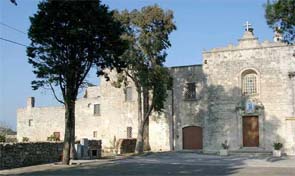 When I first pull up at Il Convento di Santa Maria di Constanopoli, a bed-and-breakfast on the outskirts of the tiny fishing village of Marittima where I have booked two nights, I am not sure if this is the right place. There is no sign, and from the exterior no sign of life either. But I knock on a small door that looks promising and, when there is no answer, make my way around to the other side. Just then, a cheery voice calls from the top window, "Hello, I'll be right down," and a few minutes later an attractive brunette (who turns out to be one of the owners) leads me into a cloister decorated with piles of Moroccan cushions, with African walking sticks leaning against the red walls. When I first pull up at Il Convento di Santa Maria di Constanopoli, a bed-and-breakfast on the outskirts of the tiny fishing village of Marittima where I have booked two nights, I am not sure if this is the right place. There is no sign, and from the exterior no sign of life either. But I knock on a small door that looks promising and, when there is no answer, make my way around to the other side. Just then, a cheery voice calls from the top window, "Hello, I'll be right down," and a few minutes later an attractive brunette (who turns out to be one of the owners) leads me into a cloister decorated with piles of Moroccan cushions, with African walking sticks leaning against the red walls.
Il Convento, built in the fifteenth century to house the relics of one of the sackings of Constantinople (and until recently the storage area for the adjacent church), is now a nine-room upscale B&B, though describing it as such doesn't do it justice. The exquisitely restored property is the latest project of Alistair McAlpine (a protégé of Margaret Thatcher's and the former head of the British Conservative party) and his wife, 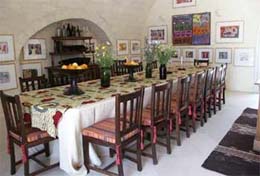 Athena. It is piled with African, Indian, and Aboriginal art and artifacts—in addition to a book collection so large that a separate library is being constructed. Antique Indian posters and bedouin photographs decorate the walls of my room. Textiles on the beds and sofas come from Morocco, Indonesia, China, and Afghanistan. Thick linen sheets are ironed off the bed and then again once they're on, a process that makes them the perfect mix of crisp and soft. At night, the smaller outdoor courtyard is lit by candles, and wine comes in unlimited quantities at no extra cost.
Breakfast the next morning—a meal that could feed a hundred, although there are only ten guests—consists of mounds of peaches, pomegranates, grapes, and figs, as well as sliced melon, fresh-squeezed juices, yogurt, cereal, and fresh-baked bread with honey, marmalade, and jam. The foccacia from the local forno is topped with roasted tomatoes, potatoes, and leeks. Lowly imitators of the breakfast buffet should be dragged here to see the real thing. Athena. It is piled with African, Indian, and Aboriginal art and artifacts—in addition to a book collection so large that a separate library is being constructed. Antique Indian posters and bedouin photographs decorate the walls of my room. Textiles on the beds and sofas come from Morocco, Indonesia, China, and Afghanistan. Thick linen sheets are ironed off the bed and then again once they're on, a process that makes them the perfect mix of crisp and soft. At night, the smaller outdoor courtyard is lit by candles, and wine comes in unlimited quantities at no extra cost.
Breakfast the next morning—a meal that could feed a hundred, although there are only ten guests—consists of mounds of peaches, pomegranates, grapes, and figs, as well as sliced melon, fresh-squeezed juices, yogurt, cereal, and fresh-baked bread with honey, marmalade, and jam. The foccacia from the local forno is topped with roasted tomatoes, potatoes, and leeks. Lowly imitators of the breakfast buffet should be dragged here to see the real thing.
With no Web site and a British cell phone number, Il Convento feels like an aristocratic speakeasy that has the trappings of an informal but luxurious house party. It seems almost out of place among the fishing villages nearby. But perhaps Il Convento's owners aren't really such an anomaly in Puglia. In fact, Athena McAlpine strikes me as no more out of place than a leopard carved on the facade of a cathedral—just another example of the latest invasion. It remains to be seen how this new wave of tourism will impact Puglia, but I imagine that this resilient region will be able to absorb the changes while stubbornly retaining its own particular flavor of Italy.
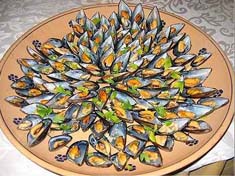 Puglia's cuisine has two sources. On the coast, the table is dominated by Mediterranean seafood: whitefish such as sea bass and swordfish; shellfish, including mussels and urchins; and anchovies. In the interior, the menu changes and the prices plummet. There are hearty pastas, baked dishes such as eggplant parmigiana and zucchini with cheese in a terra-cotta dish, and plates of earthy snails. Grilled rabbit, beef, and pork are also staples. Burrata, an extra-creamy mozzarella that's particular to the region, comes with figs and prosciutto. Puglia's cuisine has two sources. On the coast, the table is dominated by Mediterranean seafood: whitefish such as sea bass and swordfish; shellfish, including mussels and urchins; and anchovies. In the interior, the menu changes and the prices plummet. There are hearty pastas, baked dishes such as eggplant parmigiana and zucchini with cheese in a terra-cotta dish, and plates of earthy snails. Grilled rabbit, beef, and pork are also staples. Burrata, an extra-creamy mozzarella that's particular to the region, comes with figs and prosciutto.
Few places do traditional countryside dishes better than Il Frantoio, one of a new breed of working farms that double as gastronomic B&Bs. It has become famous for its nine-course meals, served three times a week and hosted by Rosalba Ciannamea and her husband, Armando Balestrazzi, who pairs the dishes with his favorite local wines. On the night I dined there, Armando chose a rosé from Salento (Puglia is one of the few Italian regions to produce a decent rosé) to accompany the thin sheets of whole-wheat pasta layered with peppers. Just-cut wild chicory, fennel, and chard with apple and olives from the adjoining orchard were served in a crispy pecorino basket, and a medley of purple and white eggplant was topped with a sweet-and-sour scapece sauce. Homemade noodles with zucchini flowers came in a saffron sauce—a vegetarian version of spaghetti carbonara.
 My favorite wine was the award-winning 2002 Torre Testa, from Salento, which came with the light pork involtini and grassy but delicate polpette (meatballs). The wine is the product of an ancient grape, susu maniello, lost for two hundred years and rediscovered only recently in a nature reserve on the coast. A delicious wild salad turned out to be made from weeds that grow beneath the olive trees. This is cucina povera, a cuisine whose dishes include anything that's available—especially during the most fruitful months, when even seasonal flowers and leaves are added, often to great effect. As Armando put it, "The suffering of the Pugliese was the mother of invention." My favorite wine was the award-winning 2002 Torre Testa, from Salento, which came with the light pork involtini and grassy but delicate polpette (meatballs). The wine is the product of an ancient grape, susu maniello, lost for two hundred years and rediscovered only recently in a nature reserve on the coast. A delicious wild salad turned out to be made from weeds that grow beneath the olive trees. This is cucina povera, a cuisine whose dishes include anything that's available—especially during the most fruitful months, when even seasonal flowers and leaves are added, often to great effect. As Armando put it, "The suffering of the Pugliese was the mother of invention."
The best way to experience the region's cultural and architectural diversity is by car. The roads are often confusing and the signs disorienting, but don't fight it. Throw away your maps and get lost in Puglia's charming, well-preserved towns. May, June, and September are the region's most beautiful months; in late July and all of August, Italian tourists take over.
| |
Sue Clayton writes on "The Guardian"
Most of us know Puglia only because of its trulli houses and Bari, port for the Greek island ferries. Few venture further south - yet Puglia's lower province, Salento, is pretty special, full of southern Italian ebullience and a heady mix of traditions.
 The remains of Greek and Roman temples and pre- historic monuments are scattered all over the dry sierras, popping up amid cactuses, olive groves and tobacco farms. The remains of Greek and Roman temples and pre- historic monuments are scattered all over the dry sierras, popping up amid cactuses, olive groves and tobacco farms.
The coast north of Gallipoli is heavily Arabic in architectural style. In villages around Castrignano dei Greci the dialect is still effectively ancient Greek. At Giurdignano, a prehistoric menhir towers over an underground Byzantine crypt, which is still used today for worship.
But go inland and there are some superb "classical" Italian towns: Lecce, known as the Florence of the South, is replete with Zingarello's baroque carved churches. And there's Gallipoli's old town on its island bridge, Oria, Manduria and Galatina.
Until the recent past, Salento was quite poor and isolated but is now enjoying a cultural renaissance and celebrating its spicy mix of ancestors and influences.
Add to this some pretty nice beaches, baking sun and a general desire to party to musical styles from pizzica to house, and you can see why the Italians themselves love the place so much.
Festivals
Every town and village has a yearly festa, so in summer there's a choice of several to attend every night. Check listings magazine QuiSalento (online at quisalento.it) or the local bar or tourist office for dates.
Many involve old religious rites, like the carrying of a Virgin Mary statue around Lecce (August 24-6) or into the sea at Otranto (September 6). Others, like Novoli have bonfires and spectacular fireworks (January 16-17).
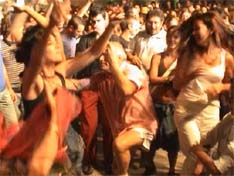 Almost all will include the pizzica, a fast and compelling rhythmic dance done to the accompaniment of the tambourine, accordion and violin. Almost all will include the pizzica, a fast and compelling rhythmic dance done to the accompaniment of the tambourine, accordion and violin.
The atmosphere is pulsing, whether it's a modest village festa or the August event in Melpignano, which has international guest stars and attracts audiences of 15,000.
Thousands of lights and torches create a carnival atmosphere. The pizzica band will start playing at 11pm and when the whole shebang gets going, you'd be pushed to match the spacey atmosphere at any nightclub.
This might be explained by pizzica's origins: though once associated with dancing out the poison of a spider-bite, the pizzica actually arrived in Salento from ancient Greece, its function being therapeutic.
Women living hard and restricted lives would dance themselves through the night into a cathartic trance. The next day they would go to be blessed at the chapel of St Paul in Galatina - a pizzica and special mass is still held there every June.
The festa is much more fun when you can pick up a tambourine and join in.
Towns
Salento's capital, Lecce, is a must. As well as the castle, the marvellous churches of Santa Croce and Chiesa del Rosario and the Palazzo Vescovile, there's a market on Mondays and Fridays around the central Piazza St Oronzo with local produce and ceramics and majolica from Grottaglie, the original home of terracotta.
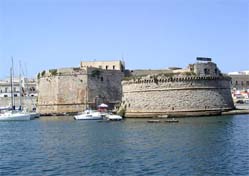 Go to the peaceful old town of Manduria, huddled around the towering Gothic church of Santa Caterina d'Alessandria. In its shadow is the ancient chapel of St Paul, another place of blessing for pizzica participators. Go to the peaceful old town of Manduria, huddled around the towering Gothic church of Santa Caterina d'Alessandria. In its shadow is the ancient chapel of St Paul, another place of blessing for pizzica participators.
Gallipoli is an architectural gem. The old town is on an island, reached by an arched bridge which is flanked by a spectacular Graeco-Roman fountain. Reminiscent of Trieste, Gallipoli's buildings pick up a subtle reflected light from the sea in the sunsets.
In the extreme south, towns get smaller and less visited. Check out Patù, Ugento, and Santa Maria di Leuca at the southern promontory (believed by Julius Caesar to be the last town in the world) and find your own back-street bar, and pleasant oblivion.
Coast
The east coast of Salento is mainly rocky with many old fortifications, while the west is flatter with sandy beaches.
The biggest resort is Otranto on the east coast, a grand fortified town important in Roman times but now dedicated solely to seaside fun. Otranto is much loved by Italians and in July and August it's seething with what must be the biggest and jolliest sea-side passeggiata in Italy.
At night it's the site of the coolest clubbing venue in Salento, with Ibiza mixes and guest DJs such as the sublime Claude Challe, creator of the Buddha Bar lounge phenomenon. Prepare to dance till dawn then crawl on to a beach-lounger and watch the stars shine and the waves roll in.
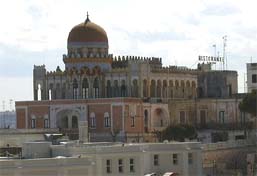 Down the coast from Otranto is Santa Cesarea Terme, a spa since Roman times. The spa today, open for treatments, is a huge 19th-century Moroccan-style edifice right on the seafront, painted in jaunty shades of blue, raspberry-pink and moss-green. Down the coast from Otranto is Santa Cesarea Terme, a spa since Roman times. The spa today, open for treatments, is a huge 19th-century Moroccan-style edifice right on the seafront, painted in jaunty shades of blue, raspberry-pink and moss-green.
South again are marvellous rocky caves and grottoes: Romanelli, Zinzulusa and Rontundella. The sea is clear azure and the area is famous for deep-sea diving.
By contrast, the west side of Salento, from the tip at Santa Maria di Leuca up to Gallipoli and beyond, is a series of small and simple resorts like Torre Pali and Torre San Giovanni, with clean white beaches.
These can be overcrowded in the Italian holidays, but are pleasant out of season. They are a safer bet for those with young children, but the east coast has more drama and rocky splendour.
|
Rick Stein writes on "The Times"
Whenever we are filming beach scenes for a television programme, we have to find an area of sand where nobody has walked — so that it looks as though the beach belongs to me and my dog, Chalky. I was thinking of that as I drove along the dusty lanes of the Salentine peninsula, in southern Italy, this summer with my girlfriend Sarah.
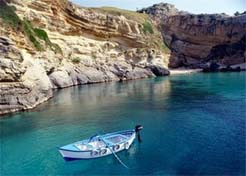 Puglia has the same feeling of being untrodden by tourists. You sense that it is still a secret. Of course there are other visitors, but there is a pleasing lack of tourist-friendly features. The road signs, for example, are most perplexing. Puglia has the same feeling of being untrodden by tourists. You sense that it is still a secret. Of course there are other visitors, but there is a pleasing lack of tourist-friendly features. The road signs, for example, are most perplexing.
I still don’t know how to tell if the arrow directing you to, say, Otranto or Lecce is pointing down the road or to the right. Either way I seemed to end up in a slightly forlorn housing project on the outskirts of town and had to negotiate an impossible number of one-way streets to get back to another limestone-hedged lane.
There is a scruffy feeling to the landscape. Unkempt olive groves, tumble-down walls and cypress trees, vineyards that drift across the flat landscapes for ever. The fields look abandoned but for caper bushes dotted here and there and lots of prickly pear cacti.
Indeed there is a slight sense of disorientation about it; Puglia is unlike anywhere else in Italy, and it’s certainly not the new Tuscany, as some have called it.
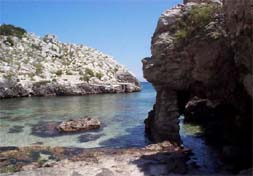 You feel deliciously lost. You will get lost anyway, whether walking, cycling or driving; the signs will confuse you, but you won’t mind because it’s all so relaxing. The slightly dishevelled look of the countryside is misleading. Puglia is actually very fertile — the volcanic soil, reliable sunshine and reasonable winter rain come together to produce abundant olive crops, one-tenth of all the wine drunk in Europe and some of the best fruit and vegetables you will ever taste. You feel deliciously lost. You will get lost anyway, whether walking, cycling or driving; the signs will confuse you, but you won’t mind because it’s all so relaxing. The slightly dishevelled look of the countryside is misleading. Puglia is actually very fertile — the volcanic soil, reliable sunshine and reasonable winter rain come together to produce abundant olive crops, one-tenth of all the wine drunk in Europe and some of the best fruit and vegetables you will ever taste.
The sweetness of the nectarines, peaches, plums, lemons and apricots heaped in bowls and on platters in Alistair and Athena McAlpine’s converted convent will remain with me for ever. The convent, which they opened to paying guests in 2003, is in the village of Marittima di Diso, south of Lecce, and the scent of those ripe, richly coloured fruits was Puglia on a plate.
Alistair bought absurdly too many of them; all so cheap at the market. I almost worried about them spoiling; almost, but not quite, not wanting to miss out on the joyous celebration of summer fruit that he was sharing with his guests.
That is what staying at Il Convento di Santa Maria di Constantinopoli, which has only eight guest rooms, is like; there is an overwhelming feeling of generosity. Everywhere you go you feel that Alistair (Lord McAlpine, a former deputy chairman of the Conservative party) and Athena want to share their enthusiasms with their guests.
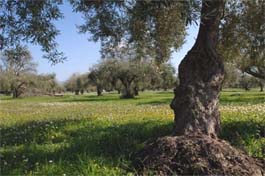 The gallery library has first editions of any book written in the past 50 years that you would like to read. In the same area there is an assemblage of about 50 little statues from Africa, local sculptors’ idea of white men, stunted little figures with a haunting mixture of Caucasian and African features. On the same floor is a gallery of northern Indian stringed instruments and everywhere there is a cornucopia of Australian Aboriginal art, rugs, drapes and carpets from the Middle East and Africa. The gallery library has first editions of any book written in the past 50 years that you would like to read. In the same area there is an assemblage of about 50 little statues from Africa, local sculptors’ idea of white men, stunted little figures with a haunting mixture of Caucasian and African features. On the same floor is a gallery of northern Indian stringed instruments and everywhere there is a cornucopia of Australian Aboriginal art, rugs, drapes and carpets from the Middle East and Africa.
It’s the sort of place you would believe existed only in a novel by Gabriel García Márquez, where dreams and reality merge. The building itself is the stuff of fantasy, a cloistered courtyard in stone and deep red plaster, lit by candlelight at night and open to the stars, surrounded by cell-like rooms with vaulted ceilings.
The kitchen and dining area are combined with a long, thick oak table where you sit for breakfast amid an overwhelming selection of jams and honey and fruit, croissants, tarts baked fresh that morning and the most delicious sourdough bread with a great thick crust and chewy, creamy interior. Outside is a pool with a beautiful stainless steel sculpture at one end, surrounded by cacti and dry limestone walls.
|
Jeremy Atijah writes on "The Independent"
Puglia? The Next Big Thing? The new Chiantishire? That's what I keep hearing. The heel of Italy, I learn, has suddenly become fashionable. Tourists are discovering that its olive oil, wine, landscape, art and culture exist in proportions previously thought to exist only in Tuscany.
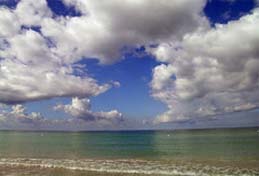 But unlike Tuscany, with its British veneer, Salento is being seen as more authentic. Or so people want to believe. Well, all right, Puglia didn't give us the Renaissance. It didn't change the world. It doesn't have Florence or Siena. It doesn't have Dante, Michelangelo, Raphael, the Medici family or the Borgias. But it does have funny little rustic cottages with conical roofs called trulli. And since the beginning of 2004, it also has three new direct air connections to the UK, where previously there were none. But unlike Tuscany, with its British veneer, Salento is being seen as more authentic. Or so people want to believe. Well, all right, Puglia didn't give us the Renaissance. It didn't change the world. It doesn't have Florence or Siena. It doesn't have Dante, Michelangelo, Raphael, the Medici family or the Borgias. But it does have funny little rustic cottages with conical roofs called trulli. And since the beginning of 2004, it also has three new direct air connections to the UK, where previously there were none.
And I confess that this is bothering me. Let me declare my interests: I love Puglia, and its gentle hills, its Baroque towns, and its funny rustic cottages. I don't want to share it with the hordes of Brtis from Tuscany. I pride myself on having found Puglia before Ryanair did. I already feel nostalgic for the days when you had to fly to Rome, and catch the overnight train to Lecce, arriving shortly after dawn in a strange southern land, dotted with olive trees and little white villages that looked as if they might be in Greece.
Back then, you never met any British tourists during your holiday. The trulli were allowed to crumble in peace. The azure sea was the preserve of effortlessly brown and beautiful locals.
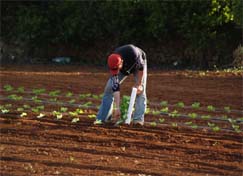 The only industry of the scuffed fishing ports was fishing. The only sounds from the interior were those of peasants fermenting their wine and pressing their olives and killing their pigs. The only industry of the scuffed fishing ports was fishing. The only sounds from the interior were those of peasants fermenting their wine and pressing their olives and killing their pigs.
But now what? I'm back, having just arrived on the new Ryanair flight to Bari (very convenient it was, too). What I want to know is: how long will it take for Puglia's lovely old towns to fill to the brim with tourists? When will the overflow from San Gimignano and Siena arrive? How long will it take before those picturesque hillsides with their ruinous trulli resound to the sounds of stonemasons laughing their way to the bank? How long until every bewildered Pugliese peasant has his very own English neighbour?
The omens are not promising. Puglia's southern climate invites year-round tourism, and as a long thin peninsula, it offers an inordinately large amount of coastline, just waiting to be developed. I've already heard rumours that several golf courses and marinas are planned.
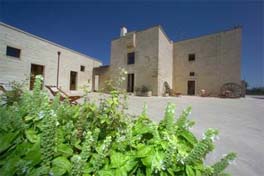 For my last couple of days I decide to get out into the countryside, to sample another kind of accommodation unique to Puglia. A masseria is the local version of a country house, or chateau. Traditionally, these grand old buildings are flat-roofed, block-shaped structures, with floors and ceilings of native Leccese stone. If you have half a million quid to spend on your Pugliese holiday home, you buy one of these instead of a trullo. Some of them, in the meantime, have been restored and converted into country hotels. For my last couple of days I decide to get out into the countryside, to sample another kind of accommodation unique to Puglia. A masseria is the local version of a country house, or chateau. Traditionally, these grand old buildings are flat-roofed, block-shaped structures, with floors and ceilings of native Leccese stone. If you have half a million quid to spend on your Pugliese holiday home, you buy one of these instead of a trullo. Some of them, in the meantime, have been restored and converted into country hotels.
I try a couple. One is the Masseria San Domenico, which offers probably the most luxurious accommodation in the whole of Puglia, with its private beach, giant swimming pool and golf course. The masseria itself is in beautiful white stone, with little Baroque flourishes; its rooms give out on to ancient olive groves full of flowers. The atmosphere is expensive and classy, though I am somewhat intimidated by the presence of security guards attending the VIP guests. The other masseria I get to try is the Melograno, which has the faint air of an Andalusian (or Mexican) hacienda about it. Its courtyards are dotted with some of the most gnarled and ancient olive trees I have ever seen in my life. With its pool and its shady gardens, this will place will succeed, I suspect, in absorbing a few Ryanair customers.
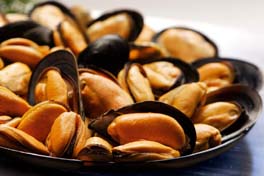 But the general problem of staying in a masseria-hotel becomes apparent at dinner time. The attached restaurant will no doubt be classy. Except the problem is this: who wants to eat in a classy restaurant in Puglia? Who wants to sit at a table next to a besuited Milanese banker and his wife, in a region where the humblest, cheapest trattoria is unfailingly excellent? But the general problem of staying in a masseria-hotel becomes apparent at dinner time. The attached restaurant will no doubt be classy. Except the problem is this: who wants to eat in a classy restaurant in Puglia? Who wants to sit at a table next to a besuited Milanese banker and his wife, in a region where the humblest, cheapest trattoria is unfailingly excellent?
From the Melograno, after dark, I escape by car a few miles down the road to the seaport of Monopoli, one of several similar ports along this coast. At ten o'clock at night its piazzas are packed with perambulating townsfolk. Waves are beating on its massive stone walls. Fishing boats are pulled up in its ancient harbour. In tiny restaurants people are ordering fishy delicacies, while old women are mourning for their sons lost at sea in winter storms of long ago, and giant old churches of weather-beaten stone are looming over the hearts and minds of all of us.
It is atmospheric rather than beautiful, but that's all right by me. None but the most dedicated aficionados of Puglia, I suspect, will ever find time for towns such as this one.
|
Zoe Williams writes on "The Guardian"
Puglia is the new Tuscany. So much is conveyed by that sentence - the food will be tasty; you won't meet Tony Blair; you won't even meet anyone English; you definitely will not find yourself on exactly the same town-to-town perambulation as another English couple with the same guidebook.
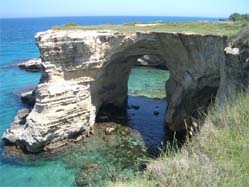 My mother and I traversed Umbria once, in a slightly dislocated version of Room With A View, in which she was much more skittish than Maggie Smith, and I was much less delightful than Helena Bonham Carter. We went from Gubbio to Spoleto to Trevi - we did it exactly as the Rough Guide instructed. I don't even think they meant us to go in that order, I think it was alphabetical. Nevertheless, two very nice seeming English couples were on exactly the same trail, in the same restaurants, at the same hotels. They eventually became friends with each other. My mother refused to talk to them, on the basis that there's nothing worse than a middle-class person on holiday, unless you happened to be us. My mother and I traversed Umbria once, in a slightly dislocated version of Room With A View, in which she was much more skittish than Maggie Smith, and I was much less delightful than Helena Bonham Carter. We went from Gubbio to Spoleto to Trevi - we did it exactly as the Rough Guide instructed. I don't even think they meant us to go in that order, I think it was alphabetical. Nevertheless, two very nice seeming English couples were on exactly the same trail, in the same restaurants, at the same hotels. They eventually became friends with each other. My mother refused to talk to them, on the basis that there's nothing worse than a middle-class person on holiday, unless you happened to be us.
Anyway, that won't happen to you in Puglia, which is in the heel of Italy, an area so undiscovered that only the Italians themselves have discovered it. This is where they take their holidays, apparently. I couldn't vouch for that, since it's hard to tell a holidaying Italian from one at work, what with all their scheduled napping.
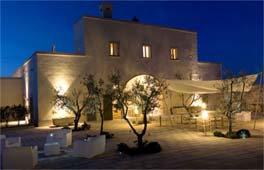 You fly into Brindisi, and you get out of it as soon as you can, since although it sounds like a town from a disco song, which will sooner or later mention pina coladas and pretty girls. I take information like that with a pinch of salt. Travel in any direction at all, however, and you'll shortly hit some or all of the things that make the place famous; in no particular order, these are the masseria, great farmhouses converted into hotels; the trulli, which are funny little dwellings shaped like beehives; the centuries-old olive trees and assorted pretty landscapes; and the amazing food. Some large percentage, which I would look up if I thought you'd remember it, of all Italy's olive oil, fish and pasta comes from this region. You fly into Brindisi, and you get out of it as soon as you can, since although it sounds like a town from a disco song, which will sooner or later mention pina coladas and pretty girls. I take information like that with a pinch of salt. Travel in any direction at all, however, and you'll shortly hit some or all of the things that make the place famous; in no particular order, these are the masseria, great farmhouses converted into hotels; the trulli, which are funny little dwellings shaped like beehives; the centuries-old olive trees and assorted pretty landscapes; and the amazing food. Some large percentage, which I would look up if I thought you'd remember it, of all Italy's olive oil, fish and pasta comes from this region.
They honestly cannot mess up food if they try; you don't even have to order from menus, most of the time, you just smile like a person who wants something tasty, and they'll bring you something tasty.
|
Lee Marshall writes on "Condè Nast Traveller"
The Salento peninsula – otherwise known as “the heel of Italy” – is a wild, invigorating place of gnarled olive trees, long drystone walls and some of the best beaches you will find anywhere in the country without taking a boat. With its strong local dialect and folk traditions – including the tarantella or pizzicata, a driving, possessed dance – it feels a little like Cornwall. The climate, however, is that of southern Italy: you can swim in the sea until mid-October, sometimes even later. The rocky eastern coast, around Otranto, is perhaps best-known among foreign visitors, due largely to its concentration of masseria hotels. However, it is the sheltered west that offers the most spectacular beaches.
Focal point is the attractive walled town of Gallipoli, jutting out into the sea that once provided its main livelihood (for centuries, Puglia’s rich olive-oil trade passed through the port). The best place to stay is the 20-room boho charmer Relais Corte Palmieri (mid-season doubles from €175), a restored 18th-century townhouse in the old town that has more stairs and terraces on different levels than an Escher print. If it’s full, the nearby Palazzo Mosco Inn is under the same management, and in a similar style and price bracket.
For a truly memorable seafood meal, head for La Puritate – famous for its antipasti (think raw king prawns, stuffed mussels) which come so thick and fast you are lucky if you make it to the pasta course. The best beaches are a short drive from the old town. Those to the north are more varied, featuring small fishing ports turned family resorts and deserted coves – including stunning Porto Selvaggio, part of a nature reserve and reached only on foot.
Don’t dismiss Porto Cesareo as a base. It’s the nearest thing to a high-rise resort in these parts – but, this being Italy, has a great deal of laidback style and charm. The beaches on either side of town (especially to the north) are magnificent. At first sight, the waterside Hotel Falli (mid-season doubles from €80) looks like an anonymous purpose-built block but its 40 rooms are tastefully done out in creams with splashes of colour, service is friendly and its mid-priced Cosimino restaurant – recommended by a chef friend from Rome – is a revelation. It’s great value if you avoid August, when room rates take a hike.
Martina Franca and the Valle d’Itria hilltowns
A fertile valley long known for its olives, wine and market-garden produce, the Valle d’Itria begins just south of Alberobello. First town of note is handsome Martina Franca, which rivals Lecce as the Late Baroque jewel of Puglia. The honey-colored local sandstone softens the elaborate façades of the town’s 18th-century churches and palazzi, and sets the place on fire at sunset.
Stay two miles south at the elegant, apricot-pink masseria resort of Relais Villa San Martino (mid-season doubles from €310) and eat in town at Il Ritrovo Degli Amici, a funky neo-Pugliese trattoria renowned for its pasta courses – notably maltagliati (flat, randomly shaped offcuts made from scraps of dough) with aubergines, tomatoes, basil and smoked cheese, and meaty secondi. In nearby Cisternino, the narrow souk-like streets of the old town boast a handful of fornelli – butchers that not only sell meat (chiefly lamb and pork) but also grill it. Vincenzo de Mola and Al Vecchio Fornello are two of the most reliable. You choose your cut of meat or your sausage (such as gnumarieddi, a mix of goat and lamb organ meats), watch it being cooked, then eat it at spartan tables out the back, with a glass of onesto local wine; the bill is unlikely to top €20 a head.
A few miles east, Ostuni hosts one of Puglia’s coolest, most Zen-like design hotels, La Sommità Relais Culti (doubles from €180). Created by style guru Alessandro Agrati, this spa retreat is frequented by Milanese fashion editors and their ilk. It’s a little frosty – but very, very stylish. Don’t miss modest but pretty Carovigno, a few miles further east on the Lecce road. There, Già Sotto l’Arco is one of Puglia’s most exciting restaurants, offering nuanced, gourmet twists on local tradition.
|
|
|
|
|
|